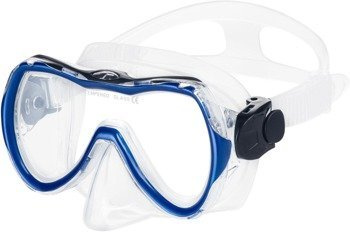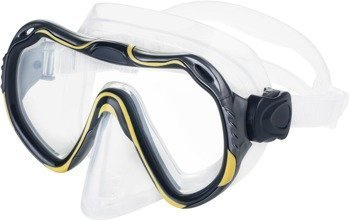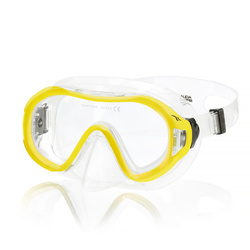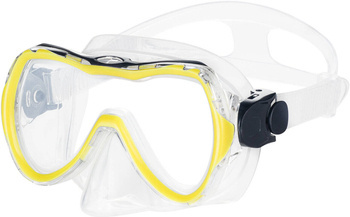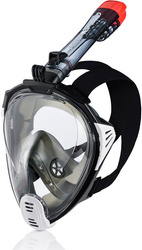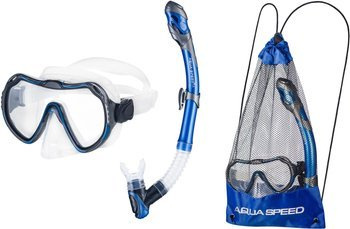What Diving Mask to Choose – What to Consider Before Buying

Diving can be both a fascinating hobby and a great way to relax, accessible to virtually anyone. Before embarking on underwater adventures, however, it’s important to learn about the necessary equipment and choose the right diving mask. What do you need to know?
Exploring the underwater world can be an incredible experience, provided nothing hinders your enjoyment. Poorly chosen equipment can discourage underwater excursions, so it’s worth taking the time to select the best option for your needs. Let’s take a closer look at diving masks and the key factors to consider when choosing this essential accessory.
Structure of a Diving Mask – What You Need to Know
A diving mask, along with a snorkel and fins, is part of the basic equipment for diving. Every diving mask consists of the following components: the lens, the frame, the sealing skirt, and the strap with an adjustment system.
Lens
Diving masks typically use lenses made from tempered glass. There are several configurations to choose from:
- Single-lens mask: The lens is not divided at the bridge of the nose, offering a seamless view and a comfortable field of vision.
- Dual-lens mask: Features two separate lenses, providing better visibility and a wider angle of view. This design also allows for corrective lenses, essential for divers with vision impairments.
- Panoramic mask: Includes additional lenses on the sides and bottom, offering a very wide field of view. However, light reflections and glare can be an issue with this type of mask.
Frame
The frame, often made of plastic, holds the lenses in place and includes attachments for strap adjustments. Frames come in various shapes and colors. Frameless masks, consisting only of the lens and silicone skirt, are also available.
Sealing Skirt
The skirt is usually made of black or transparent silicone, which is resistant to external factors and highly durable. It has seals along its edge to prevent water from entering the mask if properly fitted. Many masks include a "soft nose" section, allowing divers to pinch their nose to equalize pressure during descents. Some masks feature a purge valve, enabling the diver to clear water from the mask while underwater.
Strap and Adjustment System
The strap, made of silicone or plastic, secures the mask to the diver's head. The adjustment system ensures the mask fits snugly around the head. Most straps feature a serrated design to prevent slipping.
Amateur or Professional Diving Mask?
When deciding on a diving mask, consider whether it will be used by an amateur or a professional. Beginners often find an amateur diving mask sufficient. A full-face mask is a good choice for beginners, especially for snorkeling, as it’s easy to use and provides excellent visibility.
Professionals, on the other hand, might opt for more advanced masks, such as panoramic models with four lenses. These masks use special glass bonding technology to offer a field of view greater than 180 degrees.
Mask Size for Different Ages
Masks for children must fit perfectly to prevent water leakage, which can discourage young divers. Children's masks are designed to suit smaller faces and heads.
Proper Fit for a Diving Mask
Regardless of the type of mask chosen, it must fit the diver’s face perfectly. The skirt should seal evenly around the face with no gaps. To ensure a proper fit, consider the following:
- Seal Test: Without using the strap, press the mask against your face and inhale through your nose. The mask should stay in place without leaking air.
- Correct Size: Ensure the mask doesn't press against the nose or cause discomfort.
- Field of View: Check the mask's vertical and horizontal viewing angles. A larger field of view is generally better.
- Volume: Frameless masks have the smallest internal volume, making them ideal as backup masks that can be folded and stored in a pocket. Panoramic masks have a larger volume, but this is less critical for divers using air tanks.
- Clear Silicone Skirt: Provides a more open feeling and avoids the enclosed sensation that black silicone might create, which can be uncomfortable for people prone to claustrophobia.
Mask with Snorkel – Perfect for Snorkeling
A mask with a snorkel and fins is the basic set for snorkeling, one of the simplest forms of diving. The snorkel allows the diver to breathe without lifting their head, while the mask protects the eyes and equalizes pressure, enabling the observation of marine life. This set is also ideal for diving courses and snorkeling trips.
What to Consider When Choosing a Diving Mask. The choice of diving mask depends on your level of experience, the diving location, and your budget. Prices for diving masks vary widely, but the market offers such a broad range that everyone can find the perfect option.



